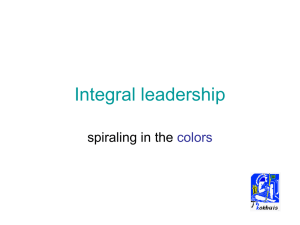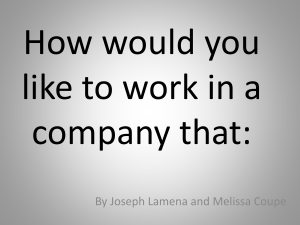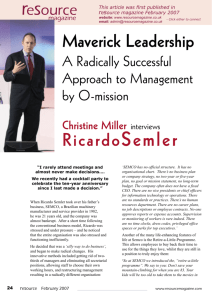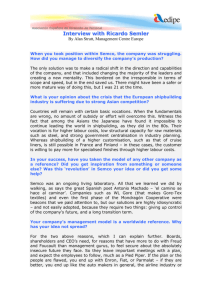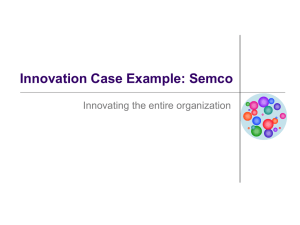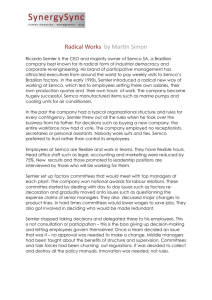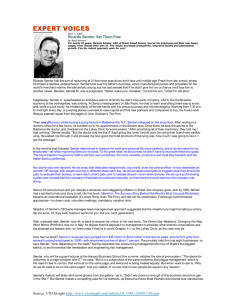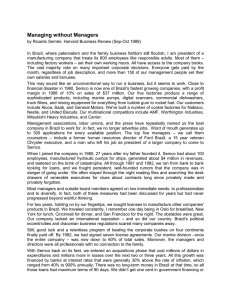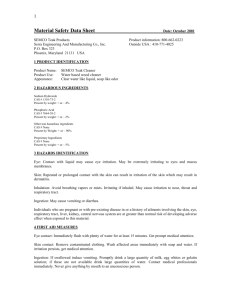Semco Case Study: Global Management & Non-Competitive Strategies
advertisement
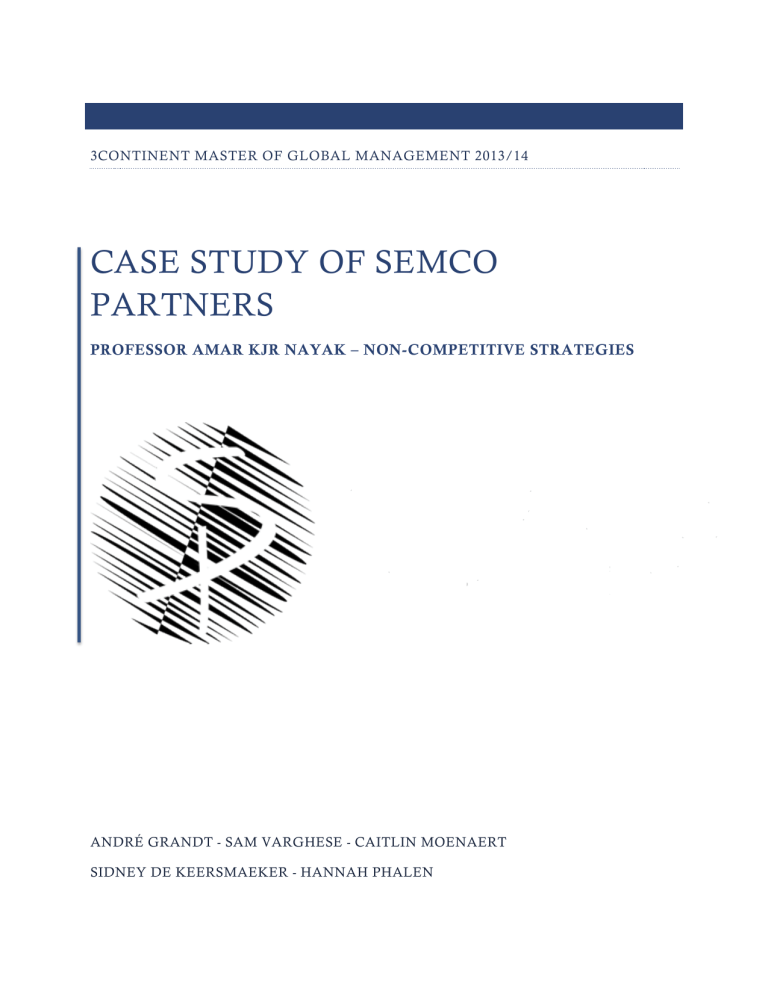
3CONTINENT MASTER OF GLOBAL MANAGEMENT 2013/14 CASE STUDY OF SEMCO PARTNERS PROFESSOR AMAR KJR NAYAK – NON-COMPETITIVE STRATEGIES ANDRÉ GRANDT - SAM VARGHESE - CAITLIN MOENAERT SIDNEY DE KEERSMAEKER - HANNAH PHALEN TABLE OF CONTENTS Introduction .............................................................................................. 2 Background ...................................................................................................................... 3 Democracy in the workplace ............................................................................................. 4 Sustainability Design .................................................................................. 5 Size .................................................................................................................................. 6 Scope ............................................................................................................................... 8 Technology..................................................................................................................... 10 Ownership ...................................................................................................................... 11 Institutionalism .................................................................................................... 11 Management Practices .................................................................................................... 12 Democracy .......................................................................................................... 13 Profit Sharing ....................................................................................................... 14 Information.......................................................................................................... 15 Performance System Evaluation ..................................................................... 16 Conclusion ............................................................................................... 18 Recommendation ........................................................................................................... 18 Key take away ................................................................................................................ 20 References ................................................................................................ 22 Appendices ............................................................................................... 23 Appendix 1: Why did we choose this company?............................................................... 23 Appendix 2: Semco financial data, 2011 .......................................................................... 24 INTRODUCTION Page 1 “THE KEY TO MANAGEMENT IS TO GET RID OF THE MANAGERS. THE KEY TO GETTING WORK DONE ON TIME IS TO STOP WEARING A WATCH.THE BEST WAY TO INVEST CORPORATE PROFITS IS TO GIVE THEM TO THE EMPLOYEES.THE PURPOSE OF WORK IS NOT TO MAKE MONEY. THE PURPOSE OF WORK IS TO MAKE THE WORKERS, WHETHER WORKING STIFFS OR TOP EXECUTIVES, FEEL GOOD ABOUT LIFE.” – R. SEMLER Semco is an active portfolio manager for a variety of corporations doing business in Brazil with its head quarter in São Paulo. Ricardo Semler, who is the majority owner of Semco describes the company as, “a diversified business centered on selling intelligence, the capacity to think out service solutions and to look at things from an intellectual standpoint”. In the beginning Semco’s main focus was on manufacturing. However, with the changes brought by Ricardo Semler in the 1980’s the company’s focus slowly shifted towards the service area as well. Manufacturing nowadays only accounts for 30 percent of Semco’s total amount of activities. The service-focused activities of Semco have an objective to look for complicated businesses that have high entry barriers. Semco’s main aim is to seek out new businesses, oversee existing businesses and promote synergies among them since global companies only have three options to enter the Brazilian market: • • Option One – They enter the Brazilian market completely on their own by forming a wholly owned subsidiary and hiring their own management team. Option Two – They can acquire an existing Brazilian company. • Option Three – They can work together with an entrepreneurial partner such as Semco. Opportunities of the third option (Semco) Threats of the first two options • Extensive network of contacts • Direct access to the target customers • Informed risk monitoring • Innovative management techniques • A brand recognized by the market • Cultural proficiency • • Language barriers (option two) Incomparable record of success in bringing multinationals to Brazil • Gap in local market knowledge (option one) • Lack of a strong network of customers (option one) • Integration and cultural transition issues (option two) • Resistance to new processes (option two) FIGURE 1: SEMCO OPPORTUINITES AND AIMS When Ricardo Semler became the CEO of Semco, the company slowly changed from an autocracy to a corporate democracy. Most academics and business people predicted that Ricardo Semler’s way of managing and doing business would destroy a once successful Page 2 company. He proved these skeptics wrong. Semco generated around $212 million on revenues and employed over 3.000 people by 2003. Even more impressive, is the employeeturnover rate of 1% between 1994 and 2004. BACKGROUND “EXPLORING OPPORTUNITIES IN BRAZIL.” – SEMCO PARTNERS Antonio Curt Semler graduated from Vienna’s Polytechnic University as an Australian engineer. Upon graduation, his goal was to find a challenging business venture abroad. In 1937, Antonio Semler accepted a job offer in Argentina. There, he managed a plant for DuPont until 1952. In 1952, Antonio Semler traveled to Brazil and realized he was keen on staying in São Paulo as he believed it to be a prime location for an entrepreneur like himself. It was in São Paulo Brazil that Semler founded Semler & Company in 1953. At this time Semco was a simple backyard machine shop. The Brazilian market offered many opportunities and Semler & Company soon became a market leader by purchasing contracts that provided marine pumps to the military. By the 1960s Semler & Company was a well-established manufacturer that employed around 110 employees and generated around $2 million on revenues a year. Semler & Company started as a paternalistic, pyramidal structured company structured with rules and autocratic leadership. This kind of organizational design was commonly found in Latin-American companies during this time making Semler & Company a traditional company in every respect. Antonio Curt Semler followed a completely different organizational philosophy compared to his son’s future management style. When Ricardo Semler graduated from Harvard at the age of 20, he began working in his father’s company. In addition to Ricardo Semler’s ideal of a strict separation of work and personal life the father and son faced a large amount of conflict. Things changed in 1982 when Ricardo Semler took over his father’s company. Ricardo Semler was convinced that the future success of Semler & Company lied in the diversification of products but nobody and especially not his father listened. Frustrated by this and the organizational philosophy of his father, Ricardo Semler threatened to leave the company in his third year. At that moment Antonio Curt Semler retired, as CEO of Semler & Company and 1982 became a turning point for the company and its employees. Ricardo Semler immediately put some drastic changes in order. He renamed the company Semco, modernized the management practices and expanded the company’s range with a product diversification strategy. Page 3 DEMOCRACY IN THE WORKPLACE “WE’RE THRILLED THAT OUR WORKERS ARE SELF-GOVERNING AND SELFMANAGING. IT MEANS THEY CARE ABOUT THEIR JOBS AND ABOUT THEIR COMPANY, AND THAT’S GOOD FOR ALL OF US.” – R. SEMLER When Ricardo Semler took over his father’s company in 1982 he was only 24 years old. He was young and ambitious and he had the aspiration to make Semco a model of efficiency. Therefore, he hired top qualified managers, adopted new and complex technology and worked long days. It was not until he suddenly fainted and was diagnosed with a severe case of stress that he realized he needed to change his way of living and that of his employees as well. That is when he came up with the idea of a ‘democracy in the workplace’, which is based on three interdependent core values, employee participation, profit sharing and free-flow of information. Profitsharing The company culture of Semler incorporates the best of many systems: • Capitalism – From the system of capitalism Ricardo Semler uses the ideals of personal freedom, individualism and competition. Employee participation Free flow of infomation FIGURE 2: SEMCO CORE VALUES • Socialism – From the theory of socialism Ricardo Semler took the importance of controlling greed and sharing information and power as important values in a company like Semco. • Japanese firms – And last but not least, from the Japanese firms Ricardo learned the value of flexibility. Ricardo Semler thinks it is crucial that Semco is a sustainable and flexible company where everyone is self-sufficient. For example, he never leaves a number behind where he can be reached when he takes off for at least two months a year to travel. This style is called the “hands-off” management style. Page 4 SUSTAINABILITY DESIGN VARIABLES “MANY PEOPLE PICTURE THE HEAD OF A COMPANY AS THE CLEAR-EYED CAPTAIN WHO PILOTS HIS SHIP THROUGH STORMY SEAS INTO CALM WATERS AND A SAFE HAVEN. RICARDO SEMLER, WHO HEADS A BRAZILIAN COMPANY NAMED SEMCO, HAS ANOTHER VIEW: HE BELIEVES IT IS HIS DUTY TO ROIL THE WATERS AND EVEN POKE A FEW HOLES IN HIS CRAFT, TO GET HIS CREW THINKING OF OTHER OPTIONS. IN OTHER WORDS, SEMLER IS A DISRUPTIVE RATHER THAN A SOOTHING INFLUENCE, AND HE LIKES IT THAT WAY.” – A. VOGL Small Size Large Multiple Scope Few Technology High Low Dispersed Simple Ownership of Resources Management Concentrated Complex FIGURE 3: SEMCO DESIGN VARIABLES; ADAPTED FROM: NAYAK, 2012 SIZE Page 5 “WE HAVE ABSOLUTE TRUST IN OUR EMPLOYEES. IN FACT, WE ARE PARTNERS WITH THEM.” – R. SEMLER Generally, organizations with a competitive mindset strive to grow in size and are primarily focused on increasing short-term efficiency in pursuance of a higher return on investment for their shareholders. On the other hand, valuable virtues such as speed of decision making, flexibility, closeness among members of organization, level of trust, etc. tend to diminish and the number of variables involved in the day-to-day business operations increase. Subsequently, the constant pressure to get bigger and bigger in size and profit maximization has lead to a number of business failures on the cost of its stake- and shareholders. Furthermore, size and purpose of organization are logically interrelated, as smaller size allows for greater frequency of interactions and greater intensity of information sharing among the members that increase the depth of relationships among them leading to greater reciprocity, trust and cooperation. As a result, in order for an organization to be and stay sustainable in the long run, it is indispensable to find a balance between short term oriented growth and profit desires and their cultural, social, and egalitarian ethics. Semco revolutionized the understanding of size as one of crucial design variables of organizations. In line with its CEO Ricardo Semler hierarchy, insufficient flow of information, and most importantly size are the main barriers of effective participatory management. Nayak argues that an organization typically moves from being a flat structure of decision making to a structure of greater hierarchy with increase in size, which normally leads to loss of control of operations. As a result hierarchies will be introduced for better control and efficiency. However, as hierarchies are introduced, distances between the participants or the member within organization increases. This leads to reduction in participation, democratic decision-making process, transparency and freedom. Ricardo Semler recognized the problems with the design variable size pretty early as well. He argued that size can be extremely disadvantageous; it creates estrangement among employees, resulting in a strong feeling of not being involved in the organization’s decision-making process. Red tape in day-to-day business life does lead to insufficient and ineffective communication between departments, turning the organization more and more into a government like entity. Concerns like this were the main motives to redesign Semco in small business units. These small units guaranteed employees to be more engaging in plans, discussions, strategies, and to finally feel more involved. In addition, it not only enabled people to appreciate and comprehend processes inside the company but more importantly to add value accordingly. Page 6 The small business units are an imitation of Semco’s main values and believes. They are completely independent; managers are free to manage as they wish. For Ricardo Semler, people at their workplace will perform at their full potential only when they know their colleagues around them, which account for no more than 150 employees in a unit: “Each business unit is small enough so that everyone involved understands everything that is going on and the outcomes. No way people can self organize if a unit is hundreds of people large.The magic number for the maximum effective size for a group is 150 and Semco will not allow a business unit to go beyond that.“ The units can be divided by product, by market or by machine, but always trying to make different people responsible for areas such as marketing, production, sales, finance, and HR in each unit. The purpose of designing the clusters like this was to give more accountability and responsibility to each team, which ultimately increases the quality of a product. In addition, the goal was to have employees operating all the equipment in their cluster and learn from each other. In this system all kinds of work fragmentation would be held to a minimum and the driving force of productivity is personal interest and motivation. Furthermore, Semco has drastically reduced their corporate staff, which provided legal, accounting, and marketing expertise to there manufacturing units, by more than 75 per cent. As a result, Semco whittled the bureaucracy from twelve layers of management to four and devised a new structure based on concentric circles to replace the traditional, and confining, corporate pyramid. Ricardo Semler himself is one out of six CEO’s, called Counselors. The second circle consists of Partners, who are in charge of the small business units. Coordinators, whose job is to supervise, represent the third circle. The rest is called Associates. Furthermore, at Semco there is no department, no rules and no audit that can govern how much a person can spend. Trusting and giving responsibility to its employees is the way Semco found to build credibility among its employees. Consequently, workers exercise more control over their jobs and assume more voice in the company’s policy. Hence, the need of supervisors diminished. Everyone is responsible for his or her own work, so that no quality control department is needed. Every group does budgeting and every six months they get together to compile their figures. Overall, after Ricardo Semler took over the company from his father, the organization’s size was drastically reduced and the production process much leaner (he fired 60 per cent of its top management and got rid of 75 per cent of his corporate staff). Doing so, he always put a strong focus on human equality and the importance of each individual, ensuring employees to be more participative. His attitude to put people’s happiness first rather than the company’s profit is commendable and the controlling nature of a firm is indeed against the human spirit of freedom and the democratic principles. Page 7 FIGURE 4: HIERARCHY OF SEMCO SCOPE “FLEXIBILITY GUIDED BY COMMON SENSE BECAME THE RULE RATHER THAN THE EXCEPTION.” – R. SEMLER Antonio Curt Semler developed a centrifuge that could separate lubricating oil from vegetables. Brazil was a land of opportunity, ravenous for all sorts of new products. In no time the Semco centrifuge became a market leader and three Brazilian partners came aboard with badly needed capital and knowledge of the country. Between the 1950s and 1960s, when the Brazilian economy was flourishing, Semco developed from a backyard machine shop into an established manufacturer employing about 110 people and generating revenues of $2 million per year. As Brazil decided they needed shipbuilding industry, Antonio Curt Semler sensed the opportunity and with help of two british pump manufacturers Semco became a major supplier of marine pumps in Brazil, a line of products for which it is still known. However, only twenty years later Brazil’s shipbuilding industry was among the hardest hit sectors as the domestic economy experienced a major downturn. This was devastating for Semco, for by 1980 ninety per cent of their business was in marine products such as pumps, components for propellers, and water-oil separators for ship motors. That was the time when Ricardo Semler was convinced Semco’s only chance for survival was to broaden its product line and reduce its dependence on the marine business. It was about time for diversification in his opinion. But whenever he brought up the suggestion of scope, the company’s managers argued that Semco is a highly focused company and that if they lose their specialized skills, they would lose everything. However, as Ricardo Semler’s dad was finally convinced Ricardo took over the company and revolutionized its philosophy. Nowadays Semco manufactures an impressively varied roster of products with over two thousand different products, including marine pumps, commercial dishwashers, digital Page 8 scanners, filters, and mixing equipment, and diversified into banking and environmental services. Furthermore, in the late 1980s, Semco the Nucleus of Technological Innovation (NTI) teams. The stated aim of the group was to invent and reinvent new products, refine marketing strategies, expose production inefficiencies, and dream up new lines of business. They would choose their areas of activity, set their own agendas, shift assets as they pleased, and have complete freedom to change their minds. It quickly became a fast-moving and successful model for change at Semco. In 1990, Semler and his senior managers decided to encourage the creation of more satellites like NTI throughout the organization, because employees wanted to become entrepreneurs but were unable to do so because of liquidity constraints. Ricardo Semler decided to turn their desire into a win-win situation. He offered to fire them, and then helped them use their severance to establish their own business and leasing them Semco machinery at favorable rates. In doing so, he encouraged employees to become entrepreneurs by helping them to overcome their liquidity constraints. At the same time, this Satellite Program allowed Semco to focus on its core competences and increase its flexibility. Such satellites possessed an enormous potential in helping release the creative, entrepreneurial spirit of other employees. They turned out to be among the most innovative and agile divisions within Semco. Workers thrived on complete accountability and responsibility, understanding that failure to perform to expectations would result in the likely discontinuation of their unit. Today, roughly two-thirds of Semco’s new products come from satellite companies, and two-thirds of is employee’s work in these organizations. FIGURE 5: NTI TEAMS In addition, Semco thrives to not only diversify their product portfolio but also the scope of employees’ knowledge and skills is highly valued; Semco has a job rotation program in which 20 to 25 per cent of their managers make a shift with each other in any given year. There is no job security at Semco as an employee has a minimum of two years and a maximum of five years in the same job before he or she is challenge to rotate, but it is up to the employee to take the initiative. Page 9 TECHNOLOGY "THE TRULY MODERN COMPANY AVOIDS AN OBSESSION TECHNOLOGY AND PUTS QUALITY OF LIFE FIRST." – R. SEMLER WITH As Semco’s company culture transformed focusing on workers being independent and selfreliant there were changes taking place regarding the company infrastructure. The company chose to fully divide the Semco facility into three separate plants. This included separating the entrances, inventory, receiving docks, telephones, certain auxiliary functions such as personnel, management information systems and internal controls. Semco formed three independent PC-based systems and got rid of the company mainframe. This separation created three autonomous companies within Semco; Semco is dependent upon a reliable technological platform to share information within the company. The goal of Semco was for workers to operate machinery and complete the necessary tasks in their cluster; this style of organization is called manufacturing cells. This system is driven by motivation, interest and productivity. In a manufacturing cell system machines are grouped together in a circle shaped formation. This lowers material flow resulting in reduced travel for material, inventory and overall production time. Semco believed workers should be able to operate machinery and complete the necessary tasks in their cluster. The following chart exhibits the advantages and disadvantages of the manufacturing cell model according to Semco: Advantages Disadvantages Inventory levels fall to lower levels workers Takes more time to manufacture a product than on a traditional assembly line Does not tie up capital Shortened delivery times FIGURE 6: MANUFACTURING CELLS; ADVANTAGES AND DISADAVANTAGES Page 10 OWNERSHIP “ALWAYS SAY WHAT YOU THINK. DON’T BE JUST ONE MORE PERSON IN THE COMPANY.” – SEMCO SURVIVAL MANUAL Ricardo Semler is the majority shareholder at Semco. The remainder of the shares is in the hands of private investors or employees. Since Ricardo Semler possesses the majority of the shares, he has the ability to interfere or even abolish the employees’ decisions. However, he will never oppose to popular decisions as that might have serious consequences. Not respecting the company’s internal democracy would not only demotivate employees –they no longer believe in Semco’s system, it would also go against everything Semco stands for. Therefore Ricardo Semler will always abide by the democratic process within his company, even when he doesn’t agree. INSTITUTIONALISM “…Raised in Semco’s culture and set them free.” - R. Semler The company culture of Semco promotes employees to be self-sufficient and independent of supervision and management. Semco management believes they have succeeded when employees at all levels within the company are able to manage themselves without any supervision. The company transformation from an autocracy to an entrepreneurial democracy took over fifteen years. Throughout this reconstruction period of Semco, corporate staff was reduced by 75%. This guaranteed the remaining head staff had the same ideals and believed in the same culture as Semler. This type of company culture and a company with values such as Semco’s was virtually non-existent and is not possible without employees who fully support company values. With a turnover rate of less than 1%, individuals who work for Semco become part of the Semco culture and Semler’s legacy. When there is an position needed to be filled Semco no longer uses advertising or job boards but chooses instead to rely on word-of-mouth; this has consistently generated over 300 resumes a week no matter the position. Each employee is held responsible for their own work ethic and is empowered by the company to work as they best see fit and in their preferred style. The applicants are not applying for the company; rather they are applying to be part of the company culture. Although Semler was key in the organization and foundation of the unique culture Semco possesses, the company culture is now its entity and has become institutionalized. This will not change once Semler leaves company. The following section, Management Practices will depict the forces Semler put in place to ensure his legacy continues long after he is gone. Page 11 MANAGEMENT PRACTICES “PEOPLE ARE RESPONSIBLE ADULTS AT HOME. WHY DO WE SUDDENLY TRANSFORM THEM INTO ADOLESCENTS WITH NO FREEDOM WHEN THEY REACH THE WORKPLACE?” – R. SEMLER Workers set their working hours, vote on important corporate decisions and have access to the company books. Semco’s management practices are unconventional and entirely different from those of any other large company. They are also the root of Semco’s success, since they lead to high employee motivation and collaboration. The company believes that growth and profit is a product of how people work together. It is precisely the management’s role to facilitate tis collaboration. In many corporations, however, managers fail to do so and stifle employee motivation and creativity trough excessive controls and bureaucracy. At Semco, this does not happen since employees are treated as responsible adults. Workers Information are given autonomy, responsibility Profit Sharing and are trusted to use their common sense. The freedom that employees’ get is real, i.e. all norms, regulations and rules have been abolished: examples include the fact that there is no formal dress code or that travel expenses are not verified. The philosophy is simple: if you don’t trust your employees you shouldn’t have hired them in the first place. Finally, Semco has three fundamental values on which it bases its concept of management. These values –democracy, profit sharing and information- are closely Democracy MANAGEMENT FIGURE 7:CORE MANAGEMENT VALUES Page 12 interconnected and mutually dependent. If they eliminated one, the others would be meaningless. In fact, the company’s structure, employee freedoms, union relations are all products of its commitment to these principles. DEMOCRACY “A high percentage of organizations develop a military rationale, whereby only a small number of people make all the decisions. There is little wonder, then, that people aren’t keen to get out of bed and come to work on a Monday morning.” – R. Semler The first of Semco’s three values is democracy, or employee involvement. The company believes that workers that control their working conditions will be happier than those who don’t. Consequently they will be more motivated and more efficient and productive in the long run. According to Ricardo Semler “There is no contest between the company that buys the grudging compliance of its workforce and the company that enjoys the enterprising participation of its employees”. It is important to highlight that it is very challenging to establish a true corporate democracy. About 90% of the time, participatory management is just hot air, i.e. it is often easier to talk about than do. Semco’s CEO understood this and initiated the democratic process by assuring that everyone is treated the same way. The privileges –closely linked to highly hierarchical companies- were taken away. Top managers don’t get reserved parking lots, bigger offices or any other kind of privilege for that matter. He also removed the traditional organizational chart because of the hierarchical sentiment that lied within it. Nowadays, the democracy at Semco is of representative character trough factor committees. They consist of various employees (factory workers, sales representative, engineers etc.) and the union is also represented on each committee. They meet on a voluntary basis and discuss the plant’s products, production techniques and strategy. Furthermore they regularly meet with the top managers at each plant and they also have a board mandate. The involvement of employees at Semco goes beyond the factory committees. To generate real involvement from workers, each of them has a vote that can be used for important decisions. Examples include the relocation of plants and the merger or acquisition of another company. By giving the employees a voice in the company’s policy Semco shows the importance it attaches to employees and their opinion. To further increase employee involvement and commitment, Semco promotes a sense of true ownership of the production process. More specifically, factory workers come in on their own time, set their own production quota, re-design products and even develop their own marketing strategies. The rationale is to let employees –they will have to live with the Page 13 consequences- make decisions on their own, since they are often more qualified to make them than supervisors. The practices and procedures mentioned above clearly indicate that Semco is serious about the establishment of its corporate democracy. It is safe to say their aim is not to use it as a marketing tool, since they actually ‘walk the talk’. Finally, the establishment of a corporate democracy is challenging and time-consuming. One of the main problems linked to participatory management is that of ‘free riders’. That is, how do you make sure all employees contribute evenly and care about their performance? Semco has found a very elegant solution for this problem: profit sharing. PROFIT SHARING “The best way to invest corporate profits is to give them to the employees.” – R. Semler In order to motivate employees and reward them for their continuous efforts for the company, Semco implemented a generous profit sharing program. It is important to highlight that SemcoPar (Semco Profit Sharing Program) is fully comprehensible and controlled by the employees. It fits the company culture perfectly –empower employees and let them make their own decisions- and proves the company is truly committed to its workforce. Each quarter, the profit of each autonomous business unit is calculated, 23% of that amount is divided among employees. The other 77% is used for taxes (34% in Brazil), dividends for shareholders and reinvestments. Employees organize assemblies to decide how to share the money. Generally, they decide to divide the money equally between the employees, regardless of function. It goes without saying that this system provides a great incentive for the employees. Moreover, it reinforces Semco’s corporate democracy since everyone is treated equally, from the plant manager to the cleaning personnel. Page 14 Net Profit 1400 NET PROFIT (W BN) 1200 1000 800 600 400 200 0 2007 2008 2009F 2010F 2011F YEAR → FIGURE 8: SEMCO NET PROFIT INFORMATION “If you look at any kind of organization and you think, ‘what are the foremost tools of power?’ You will find that it is information.” – R. Semler There is a free flow of information at Semco: all information is available to everyone, from the factory workers to the top executives. The company believes that in order for employees to feel involved, they have to dispose of all available information. Consequently, being well informed is a basic right at Semco and the information is presented to the workers in democratic meetings or trough e-mail. Moreover, all financial information is freely discussed and the employees have unlimited access to the company’s books. To make sure workers actually understand what they are reading, Semco- in co-operation with the labour union- developed a course to teach them to read balance sheets and cash flow statements. This emphasizes the fact that Semco genuinely cares about its employees and values their input. Finally, the great availability of information has two main purposes. First, it enables all parties to make well informed and thus good decisions. Second, it reinforces the nature of the decision-making process. Page 15 PERFOMANCE SYSTEM EVALUATION “WE WARE ALWAYS ADAMANT THAT MAKING MONEY AND CREATING A SUSTAINABLE ORGANIZATION – WHERE PEOPLE FELT ENTHUSED TO FLOCK TO ON MONDAY MORNINGS – HAD LITTLE IN COMMON.” – R. SEMLER To measure Semco’s performance on its efficiency, effectiveness and sustainability we decided to use the working definition of Professor Amar KJR Nayak: “Sustainability is a dynamic state of deep relationships among the people and all the constituents both living and non living with a micro ecological unit that strongly values the acts of sacrifice and love for each other; where the priority is to strengthen the weak and where the sprit of high external cooperation and high internal competition not only drives its own ecological unit to eternal peace, joy and happiness.” EFFICIENCY EFFECTIVENESS SUSTAINABILITY SPACE TIME CONTEXT OBJECTIVE FUNCTION VALUE BASE FIGURE 9: SEMCO PERFORMANCE EVALUATION As can be seen in figure 8 the performance variables (space/time/context/objective function/value base) focus consistently on sustainability, rather than on efficiency or effectiveness. Page 16 • Space –When analysing the company, we observe a large amount of stakeholders, ranging from corporate management and executives to factory workers or the organization’s many local partners. Moreover, these stakeholders are naturally dispersed, i.e. do not only reside in fancy corporate offices but are spread throughout different layers of society. This situation –a large amount of stakeholders spread over an entire ecosystem- makes the company sustainable. Only if an organization is in touch and allows input from all actors in its environment can it truly take them into account. Consequently, it can take actions that are both the company as the community’s best interest. Without doubt, this will result in a more sustainable situation than company’s that solely pursues their self-interest, disregarding (negative) externalities. • Time – The Company is running successfully since 1953 when it was founded by Antonio Curt Semler. Under the guidance of his son Ricardo Semler, the company was transformed from an autocracy to a corporate democracy. It is important to highlight that this transformation happened gradually and that the process took over 15 years. It also exemplifies Semco’s vision on performance and time; the emphasis is clearly on the long-term. Performance measurement spans over a longer period of time and is more democratic. Goals are not formulated top-down but are established democratically among employees. It is not hard to see the link between measuring performance over a longer time frame and sustainability; it incentives employees to take decisions that are good for the company now and in the future. Short-term performance measurement has all too often led to short-term profit maximization and irresponsible behaviour. Indeed, bonuses (short-term rewards) and the resulting risky behaviour have often been identified as one of the reasons for the most recent global financial crisis. • Objective Function – In this respect, Semco looks further than the main objective of traditional companies: profit maximization. It also takes into account the objectives of other entities in its ecosystem. The company recognized that their employees want a decent living but not at any cost: they also want sufficient time to spend with their family. Semco recognizes that successfully running a company is a constant balancing act between productivity, employee happiness and a company’s influence on its environment. Before a decision is made, a careful trade off is made between those variables, ensuring that multiple objectives are optimized. • Context – Semco is the ideal example of an open system. The company does not isolate itself from its environment. Rather, it tries to include all stakeholders trough the use of a free flow of information, absolute transparency and participative management. Moreover, Semco’s context could be considered very heterogeneous, Page 17 since there are no rules or regulations. This allows employees to express (or dress e.g.) they way they desire. Additionally, there are no privileges, which results in more frequent interactions between top executives and floor personnel (no fixed offices e.g.) • Value Base – It is safe to say that Semco has a very strong value base. The company treats its employees like responsible adults and genuinely cares about their wellbeing. Workers are given the trust and freedom they deserve, which fosters the company’s sustainability. It is important to highlight that two values are particularly present at Semco: equality and inclusiveness. Thanks to its well-developed corporate democracy, equality is omnipresent in the company. Additionally, the Semco has adopted a very holistic view, i.e. inclusiveness and integration of all stakeholders is primordial. As mentioned above, the company has implemented numerous practices to maximise employee motivation and involvement. By letting the employees ‘buy into’ its core values, the company makes itself truly sustainable. CONCLUSION “NOT LONG AGO, THE WIFE OF ONE OF OUR WORKERS CAME TO SEE A MEMBER OF OUR HUMAN RESOURCES STAFF. SHE WAS PUZZLED ABOUT HER HUSBAND’S BEHAVIOR. HE NO LONGER YELLED AT THE KIDS, SHE SAID, AND ASKED EVERYONE WHAT THEY WANTED TO DO ON THE WEEKENDS. HE WASN’T HIS USUAL GRUMPY, AUTOCRATIC SELF. THE WOMAN WAS WORRIED. WHAT, SHE WONDERED, WERE WE DOING TO HER HUSBAND? WE REALIZED THAT AS SEMCO HAD CHANGED FOR THE BETTER, HE HAD TOO.” – R. SEMLER RECOMMENDATION “PLEASURE IN THE JOB, PUTS PERFECTION IN THE WORK.” – ARISTOTLE Based on our analysis of the Semco system and the knowledge we gained during the noncompetitive course, we recommend the following to Semco in order for them to improve their design architecture as well as values, ethics, and morals to become even more sustainable in the long run. At Semco job rotation is used as a way to enrich the knowledge of its employees. Unfortunately, the rotational program includes only managers, letting out all other employees that could be beneficiary to the program and organization as a whole. The Page 18 rotation of tasks among managers may prevent the monopoly of power to one single person, shifting the authority of a post to others. It increases the managers’ skills and knowledge of the operational process and of the company as a whole, and creates an understanding for the work performance of colleagues. Thereto, job rotation diminishes the concentration of knowledge and information a person collected during the years that she/he worked in the same post, passing it forward to the next person who will then be responsible of the task. In other words, job rotation takes away the monopoly over a needed information and resource. As Semco only rotates the tasks among its managers, the distribution of power within a unit is never equally shared; the authority of the managers’ post always remains on the hands of another manager from other divisions. The opportunity to enhance the knowledge and commitment of others employees is never actual because their tasks environment never changes. In order for Semco to derive even more benefit of not only having managers with various skills, but also regular employees with a broader skills portfolio, employees in a team should not feel that the company is limiting their learning capacity and work variation. Therefore, Semco could apply the job rotation to a broader scope of regular employees or if possible to all of them because sustainability is founded on the value of inclusiveness and integration of everybody within the organization. Furthermore, while Semco is a strong supporter of democratic principles within an organization we have identified a lack of rapidity when it comes to urgent business decisions. On the one hand we strongly agree that participation and involvement should be the basic idea that comes with employment. On the other hand, when it comes down to flexibility and not missing out on highly important decisions regarding the company’s sustainability in the long run, business environment and other external factors sometimes require a quicker decision making process. Well grounded but also quickly acquired knowledge and skills can be extremely beneficial in order to maneuver around potential obstacles and show resiliency. To not lose the focus of Semco’s values and common ownership and management in the decision making process, we recommend the implementation of a task force for urgent business decisions, which are essential for the company’s long term principles. Each concentric circle of Semco’s four management layers should therefore elect two representatives who will be in charge for their respective circle when it comes down to such urgent business decisions. By putting this structure in place Semco will be more flexible and can react to unforeseen changes not only quicker but by keeping the democratic principles at their core more sustainable in the long run. Finally, we believe that Semco could make improvements regarding its use of technology. We placed the technology variable rather on the high side than on the low side of our analysis but we are convinced that technology intensity would be appropriate due to an increase in efficiency. For instance, Semco could adopt more advanced technology in order to use newer types of participation schemes. This would certainly support their participative management believe by reaching out to more employees in a short amount of time. At the Page 19 same time high technology also means application of higher amounts of capital. However, we would like to stress the point that size and source of capital employed at Semco should be carefully chosen. Optimal levels of capital should be employed as capital intensity may would lead to exclude employees not as familiar with high levels of technology and hurt the free flow of information philosophy. Professional guidance, as proven with teaching cleaning staff how to properly read balance sheets, would substantially remove the capital asymmetry. Therefore, if technology is properly implemented, leveraging the technical capabilities of the employees and creating a more efficient business ecosystem would be the result and sustainability the reward. KEY TAKE AWAY “DO NOT BE AFRAID OF BEING AN OUTLIER IN AN IMPERFECT WORLD.” – A. NAYAK Nowadays, the issues of sustainability are being seen from the triple challenges of climate change, global economic recession and cultural changes. It is also believed that the issues of unsustainability can be resolved by negotiating with science and technology. During our analysis of Semco it came to our attention multiple times that it is of immense importance to understand that these are rather macro issues in order to address unsustainability within an organization. As a result, to cure these issues will be of little long-term objective unless the micro issues and asymmetries within firms undergo an internal transformation. Looking back to our selection process on which organization we want to analyze for this course we can underline the fact that a firm can be best understood from the purpose for which it operates and the fundamental variables on which it is designed. We understood that in order for us to choose a suitable organization, we needed to appreciate the overall economic market system as well as basic assumptions of the system in which the firm operates. This goes back to the very nature of a firm, which is to grow and expand over time and by doing so enhance the wealth of its shareholders. We were lucky enough to realize that growth in terms of size and market share helps the organization reaching its objective of profit maximization, but often leads the firm to adopt environmentally abusive practices that makes the firm unsustainable in the long run. When further looking at present business models of organizations we quickly came to the conclusion that this assumption most probably holds true and inherent parts of a human being such as values, ethics, and morals were ignored. By further analyzing Semco we quickly experienced that ignoring other sources of asymmetry generating variables like size, scope, technology, management, and ownership Page 20 lead to control and minimizes freedom of the majority. Indeed, the controlling nature of firm is indeed against human spirit of freedom and the democratic principles. Overall, getting to know about a different and not mainstream perspective in terms of purpose served, organizational design, and sustainability was highly interesting. By analyzing Semco we constantly strived to put theory in practice and enormously enjoyed questioning ourselves about what kind of organizational design and institutional architecture will be required to balance the characteristics and perspectives of different levels of economic activities within Semco? Further, it has been eye-opening to the whole group how Ricardo Semler revolutionized his company’s philosophy based on simple human values. He definitely proved that there is nothing wrong of being a maverick in a business world where profit maximization, unnatural growth, and short term efficiency have taken over to the detriment of the environment, business ecosystem and finally long term sustainability. For us, Semco served as a supreme example for an organization based on a non competitive strategy and we became fascinated by the combination of theory learned in class and applied practices by Semcon in their pursuit of sustainability for the good of humanity. Page 21 REFERENCES Block, W. (2005). Lessons from Semco on on Structure, Growth and Change. Consulted on http://www.agreatsupervisor.com/articles/lessons.htm Nayak, A. KJR. (2011). Efficiency, Effectiveness and Sustainability: Basis of Competition and Cooperation. Bhubaneswar, India: XIMB. Nayak, A. KJR. (n.d.) Optimizing Asymmetries for Sustainability: Design Issues of Producers’ Organization. Bhubaneswar, India: XIMB. Nayak, A. KJR. (2012). Size: The Design Complexity for Sustainability. Bhubaneswar, India: XIMB. Killian, K., Perez, F. & Siehl, C. (1998). Ricardo Semler and Semco S.A. Retrieved from http://www.experiglot.com/wp-content/uploads/2006/09/semco.pdf Petersson, M. & Spängs, A. (2005). Semco & Freys: A multiple-case study of workplace democracy. (Master’s thesis Södertörns högskola, Stockholm, Sweden). Retrieved from http://sh.diva-portal.org/smash/get/diva2:16517/FULLTEXT01.pdf Semler, R. (1989). Managing without managers. http://www.schneede.se/assets/files/Ricardo_Semler.pdf Retrieved from Semler, R. (1995). Maverick! The succes story behind the world’s most unusual workplace Stockport, G.J. & Chaddad, F. (2001). Semco ‘A’: A Most Unusual Workplace. Retrieved from http://gsblive.uct.ac.za/instructor/usermedia/1651/Semco%20Case%20Study.pdf Semco Partners. 2013. Retrieved from http://www.semco.com.br/en/ Shinn, S. (2004). The Maverick CEO. Retrieved from http://www.semco.com.br/en/wpcontent/uploads/2013/pdf/bizEd-february-2004.pdf Vogl, A.J. (2004). The Anti-CEO. Consulted on http://www.semco.com.br/en/wpcontent/uploads/2013/pdf/the-conference-board-review-article-june-2004.pdf Page 22 APPENDICES APPENDIX 1: WHY DID WE CHOOSE THIS COMPANY? As students of the 3Continent Master of Global Management program, we are well aware that sustainability and corporate social responsibility are becoming increasingly important in the current competitive environment. We enrolled in this program to become global managers with a clear vision. A vision that goes beyond simply generating value for the shareholders but that also stresses the change needed in our way of doing business in order to attain a better and more sustainable world. Semco fits this vision perfectly. Ricardo Semler has showed that things can indeed be done differently; that employees can and should be trusted and empowered, that traditional organizational designs are outdated and that equality and inclusiveness can have numerous benefits. Therefore, Semco was also a choice of hope and inspiration. It reminds and motivates us to remain critical and to constantly challenge economic certainties or any other certainties for that matter. “Do not go where the path may lead, go instead where there is no path and leave a trail.” -Ralph Waldo Emerson- Page 23 APPENDIX 2: SEMCO FINANCIAL DATA, 2011 Page 24
